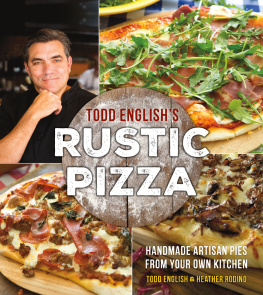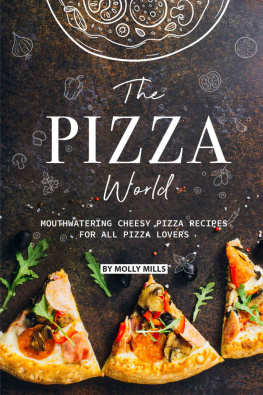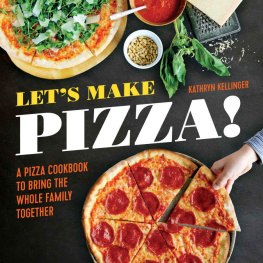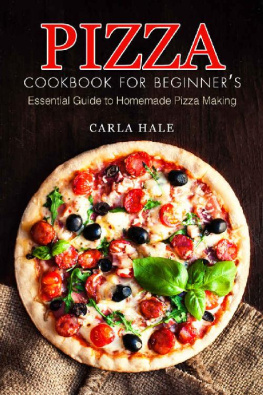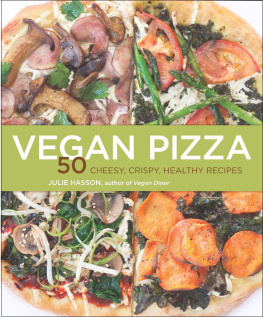Contents
Guide
TODD ENGLISHS
RUSTIC
PIZZA
HANDMADE ARTISAN PIES
FROM YOUR OWN KITCHEN
TODD ENGLISH &
HEATHER RODINO

The author and publisher have provided this e-book to you for your personal use only. You may not make this e-book publicly available in any way. Copyright infringement is against the law. If you believe the copy of this e-book you are reading infringes on the authors copyright, please notify the publisher at: http://us.macmillanusa.com/piracy.

For many years, my motto has been Never trust a round pizza. An artisanal rustic pizza, made lovingly by hand, will never be perfectly round like its mass-produced counterpart. That imperfectionthe fact that its a little different every timeis what makes rustic pizza special. And I should know. Ive been obsessed with pizza for a long time. Ever since I lived and worked in Italy, I ate every kind of pizza I could lay my hands on. I went north, south, east, and westall over the country, trying all of the amazing pizzas I could find. From its origins in Naples to newer international influences, pizza is endlessly adaptable and never gets boring. With all of the varied and innovative recipes in this book, I promise that you will never look at pizza the same way again.
One of the most fascinating things I learned from my long research into all things pizza is that this food we now call pizza is actually a recent iteration of an ancient style of food, based on enhancing the nutritional and flavor profiles of bread. Since ancient times, people have been adding various toppings to bread, and cultures around the world have their own flatbreads. In fact, pizza is thought to have evolved from an Egyptian flatbread. But theres also naan from Central and South Asia, pita from the Middle East, injera from Ethopia, lavash from Armenia, flatbrd from Norway, tortillas from Mexico, and dozens of other flatbreads from all over the world. Many of these are served with traditional toppings, stuffed, or torn and used to scoop up foods. Like these other foods, pizza is essentially a flatbread with toppings, and while modern traditional pizza traces its roots back to eighteenth-century Naples, within Italy itselfin Sicily, for example, where pizza is thick and rectangulardifferent kinds of pizzas have evolved in different places. (As of 2009, Naples pizza received the EUs Traditional Specialty Guarantee protection status.) The tomato,, a New World food that today seems inseparable from Italian cuisine, didnt arrive in Italy until the mid-sixteenth century. Pizza gained massively in popularity after World War II, when G.I.s who had been stationed in Italy returned to the U.S. with a taste for pizza. Thus, the modern pizza was born and continued to change over the twentieth century into the vibrant and diverse pizza culture we have today.
And without a doubt, today pizza is among Americas favorite foods. Its certainly one of the most ubiquitous. Its part of my own roots as an Italian-American as well. Although this important food from Italy continues to evolve, even just within the American context, pizza can be a surprisingly hot-button topic, with arguments over authenticity and whether or not a topping even belongs on a pizza. Dont believe me? Try getting a New Yorker and a Chicagoan in the same room to duke it out over which is better, thin-crust or deep-dish pizza (or, for that matter, whether deep-dish pizza really is pizza). Or bring up the words anchovy, pineapple, barbecued chicken, and pizza at your next dinner party and see where the conversation goes. The point is that we all have an opinion about an ingredient or style that we believe disqualifies a pizza from being a pizza. Fortunately, we dont need to settle these controversies, or have a universally accepted definition of pizza, in order to enjoy everything this wonderfully versatile food has to offer.
My goal has always been to create different, inspired pizzas, always pushing the envelope. As a professional chef, I know what satisfies my customers, and as a father, I know whats a crowd pleaser among the junior set. And so, with Rustic Pizza, I want to offer you my latest insights; new takes on old favorites as well as creative combinations. While there are many traditional red-sauce pizzas in this book, youll find many otherand perhaps surprisingrecipes that will have you thinking outside the (pizza delivery) box. Maybe its the Roasted Pear, Camembert, and Watercress Pizza (see ). Its my hope that this book will help you push the boundaries of what pizza can be, and that soon, with a bit of practice, youll start to combine flavors, textures, and toppings in your own way. If youve got kids, involve them in the process of measuring, mixing, watching the dough rise, and then decorating their own pizzas. Its a way of making cooking a family event and an opportunity to share and celebrate together in the best way possiblewith great food.
When choosing toppings for your pizza, try to go for simple, seasonal, fresh ingredients that are local to your part of the world. Choose organic whenever you can, and get to know your local farmers market. It will fill you with ideas.
Another tip; Dont overload your pizza with sauce or toppings. Too much sauce in particular will make it soggy, and you wont get the crisp crust youre looking for. As I always say, when it comes to pizza, less is more!
With more than 100 individual pizza recipes, plus dozens of toppings and sauces that you can mix and match, Rustic Pizza offers virtually unlimited combinations. You can have a different pizza every night! While rustic pizzas are quick to assemble, they sometimes require a bit of prep to get all of those fabulous layers of flavor. Fear notmost of the topping prep is simple. Do that first, and once you finish, come back to your pizza recipe and youll see that everything is simple and laid out on one page. Also, make use of your freezer; if youve got tomato sauce or pesto and a few prepped toppings in the freezer, and you pick up some prosciutto or roast chicken on the way home, a rustic pizza dinner could be just minutes away!
With the exception of the Sicilian-style pizzas in chapter 7, the recipes in this book make two pizzas, each serving one to two people. They only take a few minutes to cook, so have a glass of wine or a cold beer while you wait, and hang out in the kitchen chatting with your guestsmake it a pizza party!
EQUIPMENT, TIPS, AND TRICKS
I dont want to place the bar for making good pizza too high, so Im not going to suggest that you load up your kitchen with a lot of needless gadgets. However, there are a few key items that are good to have on hand. You might already own many of them.
BAKING STONE OR STEEL Almost every recipe in this book starts with preheating the oven with a baking stone in place.
A baking stone, also known as a pizza stone, is a large porous stone slab that helps mimic the conditions of a commercial pizza oven, though your home oven will never get as hot as a pizza ovenwhich can reach 800F or more! Place the stone on the ovens bottom rack and bake the pizza directly on the stone. This will help maintain a steady oven temperature and produce a more pizzeria-like crust. Note that baking stones are fragile and prone to cracking due to sudden temperature changes, so you cant just stick one in a hot oventhe key is to start with a cold oven and give the stone a chance to heat gently all the way through.

